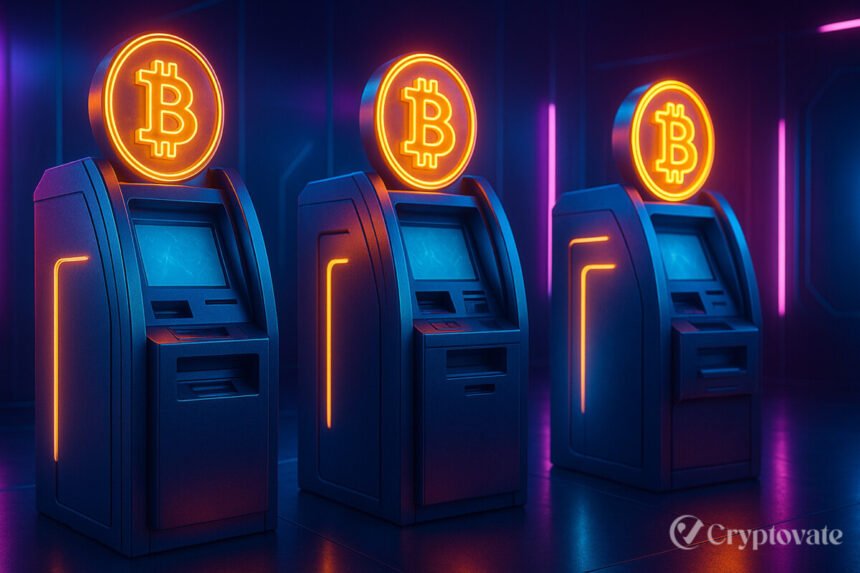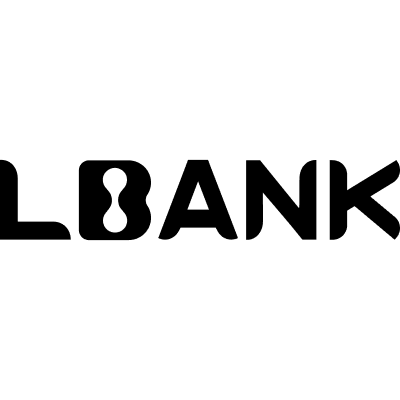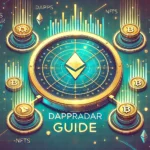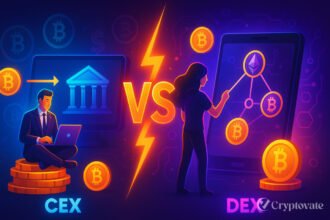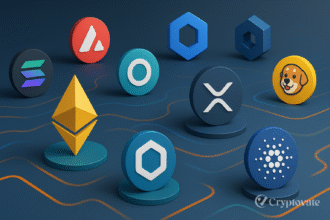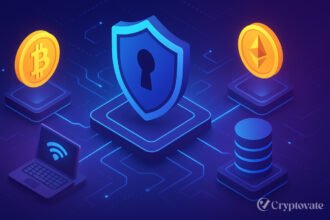– Ad –
| Getting your Trinity Audio player ready... |
Bitcoin ATMs offer the simplest way to convert cash into cryptocurrency. Walk up, scan a wallet QR, feed in cash, and you’ve got bitcoin on-chain within minutes. No spreadsheets, no bank delays, no “we’re verifying your documents for 72 hours.” But speed has a price, usually higher fees, and a few traps you should know before you press “Confirm.”
Let’s break it down.
What is a Bitcoin ATM (a.k.a. BTM)?
A Bitcoin ATM is a terminal that allows you to purchase (and sometimes sell) bitcoin using cash or a card. Think of it as a crypto on/off-ramp in the wild:
- Buy flow: Scan your wallet’s QR code, deposit cash, confirm the transaction, and get bitcoin sent to your address.
- Sell flow (two‑way machines): Send BTC to the machine’s address → wait for confirmations → withdraw cash.
Most machines require a phone number OTP, ID scan, or KYC for larger amounts. Locations range from malls and convenience stores to airports. Availability and legality vary by country and city, always check local rules before you go.
Why use a Bitcoin ATM?
Speed. You can be in and out in under five minutes once you know the steps.
Cash-first. Ideal if you’re paid in cash or don’t want to link a bank account.
On-chain control. Funds land directly in your self-custody wallet if you choose.
Trade-offs:
- Fees exceed those of exchanges, typically including a percentage markup and a flat fee.
- Rates can include a spread from the global market price.
- Limits per transaction/day to meet compliance rules.
- Location risk: not every kiosk is maintained equally.
How do Bitcoin ATMs work?
- KYC/Verification:
- Small amounts may need just a phone OTP.
- Higher tiers require ID scans (passport/driver’s license) and sometimes a selfie.
- Wallet & Address:
- Bring your wallet app ready.
- Tap “Receive,” show your QR code, confirm it’s a BTC address (not Lightning or another chain unless the machine supports it).
- Payment:
- Insert cash or pay by card (if supported).
- Check the machine’s quoted price, fees, and network fee.
- Broadcast & Receipt:
- The kiosk broadcasts a BTC transaction to your address.
- You’ll receive a receipt or SMS containing the transaction details.
- Funds appear after network confirmations (from seconds to ~10+ minutes depending on fees and congestion).
For selling BTC? The machine displays an address/QR → you send BTC → it waits for confirmations → it dispenses cash or issues a redeem code.
Also Read: New Zealand Cracks Down: Crypto ATM Ban and $5,000 Cash Limit to Fight Money Laundering
Fees, limits, and the “real” price
- Percentage fee: A markup on BTC price (e.g., 6–12%+).
- Fixed fee: A small flat cost per transaction.
- Network fee: The on-chain miner fee can spike during busy periods.
- Daily limits: Common ranges are a few hundred to a few thousand (local currency), depending on KYC level.
Pro tip: If the kiosk fee looks high, open a price app and compare the spread. For larger buys, a reputable exchange usually wins on cost. For small, urgent cash buys, the ATM’s convenience may be worth it.
Safety and Privacy Checklist
- Use your own wallet. Avoid paper wallets the machine prints unless you fully understand how to sweep funds.
- Double-check the address. Scan from your wallet; verify the first/last characters.
- Beware of scams. If someone is telling you to deposit cash into a Bitcoin ATM “to pay a bill, tax, or fee,” walk away.
- Stand to the side. Shoulder surfing is real. Shield your screen and cash.
- Save the receipt. It helps with support if something goes wrong.
Are Bitcoin ATMs legal everywhere?
No, rules differ by country and even by state. Some regions require operators to hold money service licenses or register with regulators. Others restrict or ban ATMs outright. Laws also change. Before you plan a trip just to use a BTM, look up local regulations and current locations. This is general info, not legal advice.
When a Bitcoin ATM makes sense (and when it doesn’t)
Use a BTM if:
- You need BTC fast with cash.
- You’re traveling and don’t want to link a new bank account.
- It’s a small, one-off buy, and convenience beats saving a few percent.
Skip the BTM if:
- You’re buying a meaningful amount and want the best possible rate.
- You’re comfortable with exchanges and bank transfers.
- You need advanced order types or recurring buys.
Middle ground: Do a small test buy at the ATM to confirm the process, then decide if the fee is worth scaling.
Step-by-step: first-time buy
- Install a reputable wallet (self-custody).
- Back up your seed phrase offline. Don’t screenshot it.
- At the kiosk, choose Buy, accept the terms.
- Complete verification, if prompted.
- Show your BTC receive QR from the wallet.
- Insert cash; confirm the amount and final BTC you’ll receive.
- Approve; keep your receipt.
- Watch the wallet for confirmations. If it’s slow, check the transaction ID on a block explorer.
The future of crypto kiosks
Expect more multi-asset support, Lightning options where allowed, better KYC UX, and tighter compliance. Fees should compress where competition increases, but convenience will always carry a premium. If crypto adoption continues, BTMs remain a handy on/off-ramp—especially for cash-heavy users.
FAQs
Are Bitcoin ATMs anonymous?
Not really. Most require at least a phone number, and bigger buys need ID.
How long does it take?
Often minutes. Network congestion and confirmations can add time.
Can I send to an exchange address?
Usually yes, but self-custody is safer for first-timers. If you must, confirm the correct deposit network and memo/tag rules of the exchange.
What if my coins don’t arrive?
Use the receipt to contact the operator. Check the block explorer with your transaction ID.



